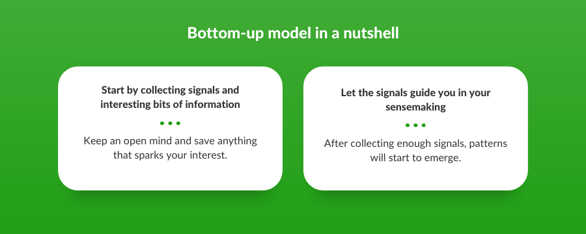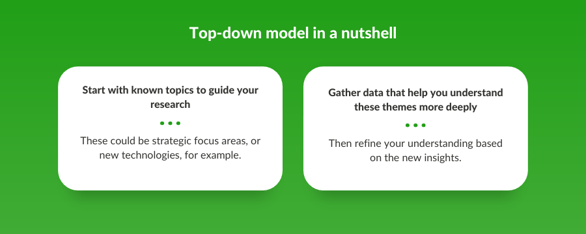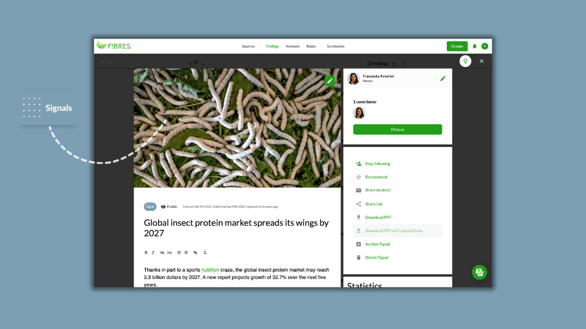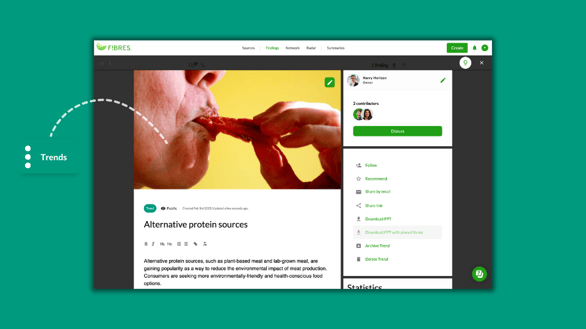Comparing the bottom-up and top-down models for foresight

When it comes to your in-house foresight work, it's important to choose the right approach for your organization.
There are two main approaches or workflows that organizations can take: the bottom-up model and the top-down model. The bottom-up model involves starting with weak signals and using them to uncover emerging trends and topics, while the top-down model begins with known topics and areas of interest.
Let's compare the two models.
The bottom-up model: start from weak signals

The bottom-up model is a great way to approach foresight work because it allows you to start with the small, seemingly insignificant signals that often go unnoticed. By collecting these signals and analyzing them, you can uncover new trends and emerging topics that may have otherwise been overlooked.
By collecting these signals and analyzing them, you can uncover new trends and emerging topics that may have otherwise been overlooked.
This approach is particularly useful for individuals or organizations that are looking to stay ahead of the curve and anticipate future changes and developments. With the bottom-up model, you can start with a blank slate and let the signals guide your thinking, leading you to new insights and ideas that you may not have considered otherwise.
So if you're someone who is responsible for exploring new ideas and uncovering hidden connections, the bottom-up model may be the perfect approach for you.
The top-down model: start from known topics

With the top-down model, the focus is on starting with known topics and areas of research that require more understanding. This approach is particularly useful for organizations that have identified specific areas of interest or concern.
For instance, if you work for a city planning department, you might already be aware that sustainability and new mobility solutions are pressing themes that requires further exploration. By starting from this point, you can gather data and insights that help you understand the dynamics of these themes more deeply.
The top-down model is a great way to ensure that your foresight work is grounded in practical concerns and real-world challenges, while also providing a clear direction for your research efforts.
By starting from this point, you can gather data and insights that help you understand the dynamics of these themes more deeply.
What you need to succeed: team and tools
To effectively implement the top-down and bottom-up models of foresight work, it is essential to have a team responsible for consolidating the data. This team should be made up of individuals with diverse expertise and perspectives, who can help to identify and analyze trends and signals from different angles.


Additionally, it is crucial to have a place to save the data that is collected. This could be a dedicated database or platform, where all the information and insights can be stored and accessed by the team members. It is important to ensure that the platform is user-friendly and easy to navigate, so that the team can quickly and efficiently access the information they need.
One tool that can help with this is FIBRES. It's a foresight tool that allows teams to collect and analyze data from a variety of sources, and provides a range of tools and visualizations to help make sense of the information. With FIBRES, teams can collaborate and share insights, ensuring that everyone is on the same page and working towards a shared understanding of the future.
Which model should you use?
Are you wondering which approach to choose for your foresight work? Both models have their advantages, and the approach that is best for your organization will depend on your specific goals and needs.
Whichever way you go, consider using FIBRES to help with foresight data collection and analysis.
If you are looking to explore new ideas and uncover hidden connections, the bottom-up model may be the perfect fit for you. On the other hand, if you have specific areas of interest that require further exploration, the top-down model may be the way to go. Whichever way you go, consider using FIBRES to help with foresight data collection and analysis.
And remember: The key to successful foresight work is staying open-minded and adaptable. By keeping your options open and remaining flexible in your thinking, you can ensure that you are able to identify emerging trends and opportunities, and stay ahead of the curve in an ever-changing world.
Milla Rogge is head of marketing at FIBRES. She's excited to learn foresight best practices from the top organizations in the world already running their own foresight workflows and to share those learnings with others.
Stay in the loop
Get our latest foresight tips delivered straight to your inbox. You may unsubscribe from these communications at any time.